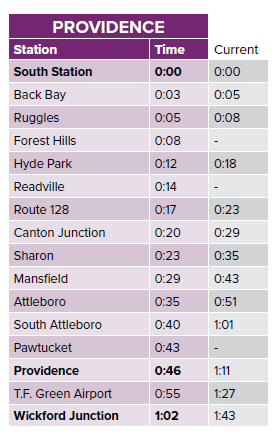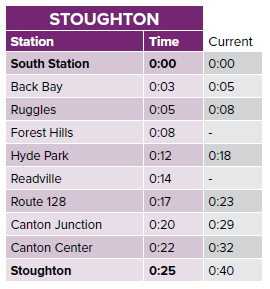Appendix C1
Providence/Stoughton Line
This section analyzes the advantages of potential infrastructure and service improvements for the MBTA’s Providence and Stoughton lines.
Providence/Stoughton line segments
- The shared Providence and Stoughton Line extends along the Northeast Corridor (NEC) from South Station to Canton Junction, a distance of 15 miles.
- The Providence line segment continues south from Canton Jct. along the NEC to Providence Station, and beyond, to Wickford Junction. This is 29 miles to Providence and another 19 miles to Wickford Jct.
- Stoughton Line segment extends from Canton Jct. to Stoughton, a distance of 4 miles.
The Providence line from South Station through Rhode Island is the only rail line in the MBTA system that has full electrified infrastructure available. Amtrak has expressed interest in the MBTA electrifying Commuter Rail service along the NEC in Massachusetts and Rhode Island.
Because the NEC is already electrified, the Providence Line offers the opportunity to almost immediately implement electrified rail service within the MBTA Commuter Rail system. Only short segments, used by the MBTA but not by Amtrak, are unelectrified.
Ridership
The Providence/Stoughton line is the busiest in the Commuter Rail system. The route has over 13,000 passenger trips in each direction every weekday. The current travel time for 43-mile route between Providence and South Station can typically take 70 minutes.
Line characteristics
Eight stations only have mini-high platforms, which are about two-thirds the length of a typical coach: Hyde Park, Canton Jct, Sharon, Mansfield, Attleboro, South Attleboro, Canton Center, Stoughton. Those stations have to be equipped with full-length high platforms; the other stations already have high platforms.
Between Boston and Providence, a distance of 43.6 miles, there are ten stops. But the potential time saving is substantial for how wide the stop spacing is, because the current MBTA rolling stock generally has a maximum speed of 79-mph, whereas much of the NEC rail line in Massachusetts and Rhode Island has speed limits of 100-150 mph.
Rhode Island is currently investing in an infill stop in Pawtucket. We believe that two more locations for infill stops are warranted: Readville, and Forest Hills. Both have stops on other lines branching off the NEC (Franklin and Needham, respectively), but would be useful on the Providence Line as well: Readville for transfers to the Fairmount Line, and Forest Hills for connections to the Orange Line.
To transform the Providence/Stoughton line to high speed EMU rail service in the nearterm,
the MBTA should:
- Procure rolling stock,
- Electrify the Pawtucket service yard, which was designed for electrification,
- Build high-level platforms at the eight stations with mini-highs,
- Electrify short track segments not used by Amtrak:
- The platform tracks at Attleboro, where the line has four tracks,
- The Stoughton line,
- The 11-mile FRIP track from Providence Station to Greenwood, Warwick, and
- The Wickford Jct. siding.
Capital investment along the NEC south of Massachusetts would be the exclusive responsibility of Rhode Island. Within Rhode Island, there are unfunded long-term plans to extend the line even further south than Wickford Jct., into Kingston and Westerly at the border with Connecticut. The state’s rail plans are compatible and complementary with Regional Rail.
MBTA subway and bus, and GATRA, BAT, and RIPTA bus service should have full fare integration with Regional Rail along the Providence/Stoughton lines. RIPTA should expand its current free transfer policy for MBTA pass holders to full fare integration for all Regional Rail fare products; a trip on a Regional Rail train within Rhode Island should cost the same as a RIPTA bus ride.
For more frequent Providence and Stoughton line service, trains should run equally at all times of day in both directions. Before NSRL opens, trains should use two captive tracks at South Station and shuttle back and forth, turning back within ten minutes to avoid congesting South Station tracks. With implementation of the NSRL there would be no need for extended dwell times at South Station as trains would potentially travel beyond to the north side of the MBTA system.
With either the current terminal service at South Station or with NSRL through train service, extended train layovers for the Providence and Stoughton line service should be at:
- Providence Station
- Stoughton
- Pawtucket service yard
- Wickford Jct.
When NSRL is established, end of the line locations for layovers on the north side should
be selected.
Train Scheduling
- Generally, trains should operate between 5 am and 1 am, 7 days a week.
- Scheduling should be consistent with recurring clockface times.
- Frequency should be the same for both inbound and outbound trains.
- The top speed should be 100 mph or more, except where constrained by track geometry. Positive Train Control, which prevents overspeed incidents, is installed and active on the line.
Frequency
Travel Times
At full rollout, with NSRL removing the slow terminal tracks into South Station, the
following schedules are feasible:
An additional small time saving, no more
than 20 seconds, could come from highspeed
rail curve modification north of
Providence. South of Providence there is
an additional potential saving from curve
modification, perhaps a full minute.



